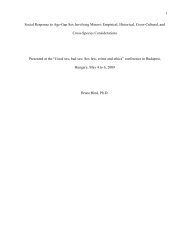Infant and Child Sexuality: A Sociological Perspective - Ipce
Infant and Child Sexuality: A Sociological Perspective - Ipce
Infant and Child Sexuality: A Sociological Perspective - Ipce
Create successful ePaper yourself
Turn your PDF publications into a flip-book with our unique Google optimized e-Paper software.
held by the eight year old. An interest in a life of one’s own with a<br />
member of the opposite sex <strong>and</strong> curiosity about that opposite sex is<br />
evident in the preadolescent’s interest in peeping, smutty jokes,<br />
provocative giggling, <strong>and</strong> the whispering, writing, or spelling of sex<br />
words. (Gesell <strong>and</strong> Ilg, 1946, p. 321, 324, 325, 369; Ilg <strong>and</strong> Ames,<br />
1955, p. 204-205).<br />
Nine year olds continue to develop but also continue to have some<br />
of the same interests as eight year olds. However, a greater selfconsciousness<br />
is apparent, <strong>and</strong> the preadolescent is conscious of his<br />
own attitudes, his home, <strong>and</strong> his parents’ <strong>and</strong> siblings’ behavior as<br />
well as of his body. Bodily self-consciousness may have progressed to<br />
where the preadolescent doesn’t desire to be seen in the nude by the<br />
parent of the opposite sex. Awareness of attitudes of others toward<br />
self is heightened as is sensitivity <strong>and</strong> embarrassment over being<br />
corrected or criticized. Self-projection is apparent in crushes <strong>and</strong><br />
hero worship. The preadolescent is oriented more toward his<br />
contemporaries than toward parents. First experiences of conflict<br />
between adult codes <strong>and</strong> the codes of contemporaries occur, providing<br />
still more opportunities for development of personal identity.<br />
The nine year old is interested in sexuality. The fact that boys<br />
<strong>and</strong> girls of nine sometimes profess to hate each other is only one step<br />
in the development of mature sexual attitudes <strong>and</strong> interests through a<br />
complex series of uncertain stages. For despite this profession,<br />
evidence of interest in sex <strong>and</strong> displays of sexual conceptions that<br />
have already been adopted are abundant. Talk about sex with friends of<br />
the same sex, interest in details of one’s own sex organs <strong>and</strong> their<br />
functions, sex swearing, <strong>and</strong> sex poems are all manifestations of this<br />
interest. The nine year old relates to the process of reproduction,<br />
sometimes with questions about fecundity--“Have I a seed in me?” The<br />
division of sexes in play is obvious. Mixed play, if it does occur,<br />
illustrates sexual interest, as kissing games <strong>and</strong> teasing about boy or<br />
girl friends is a frequent outcome. (Gesell <strong>and</strong> Ilg, 1946, p. 322, 325,<br />
370; Ames <strong>and</strong> Ilg, 1955, p. 204-205, 207-208).<br />
The channels of expression which the ten to twelve year old chooses<br />
to demonstrate interest in sex are often considered inappropriate by<br />
adults. Considerable interest in “smutty” jokes is evidenced during<br />
this period. According to Ilg <strong>and</strong> Ames, eleven <strong>and</strong> twelve years appear<br />
to be a high point for smutty jokes among children in the United<br />
States. It is part of a general growth gradient through which children<br />
pass. (Ilg <strong>and</strong> Ames, 1956, p. 207). And it is at least partly because<br />
of rapid <strong>and</strong> simultaneous development in many areas at once that this<br />
late preadolescent period is commonly characterized by displays of<br />
behavior that appear contradictory. A mixture of good <strong>and</strong> bad behavior<br />
tends to characterize the situation during late preadolescence; one<br />
where the emergence of independence <strong>and</strong> self-reliance, a dependence on<br />
individuality, antagonism between the sexes, the need for the security<br />
of gangs, <strong>and</strong> a growing knowledge of reality <strong>and</strong> objectivity all are<br />
found. All in all, these components result in what many term<br />
“uncooperative, hard to live with” preadolescents. (Blair <strong>and</strong> Burton,<br />
1951, p. 2-4).<br />
The biological changes ushered in at puberty are awesome to the<br />
preadolescent. The appearance of pubic hair is a social as well as a<br />
76
















